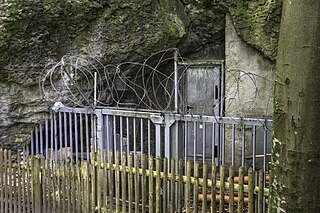Zoolithenhöhle
| Zoolithenhöhle
|
||
|---|---|---|
|
Entrance to the Zoolithenhöhle |
||
| Location: | Burggaillereuth, Franconian Switzerland , Germany | |
|
Geographic location: |
49 ° 46 '45.6 " N , 11 ° 16' 58.3" E | |
|
|
||
| Cadastral number: | D 109 | |
| Geology: | dolomite | |
| Type: | Horizontal cave | |
| Discovery: | 1602 | |
| Show cave since: | No | |
| Lighting: | No | |
| Overall length: | 1000 meters | |
| Particularities: | locked | |
The Zoolithenhöhle is a natural karst cave near Burggorienreuth , a district of Ebermannstadt in the Upper Franconian district of Forchheim in Bavaria .
location
The Zoolithenhöhle is about 400 meters west of Burggorienreuth on the northern slope of the Hohlen Berg.
description
The Zoolithenhöhle is a natural karst cave with a total length of over 1000 meters. It is one of the oldest known caves in Franconian Switzerland and of high scientific value. In the cave cadastre Fränkische Alb (HFA) it is designated with the cadastral number D 109, by the Bavarian State Office for the Environment as geotope 474H002, as a natural monument (ND-04462) and as a soil monument D-4-6233-0065. The cave is closed all year round and only accessible for scientific research purposes.
history
The name is derived from the Greek terms zoon (animal) and lithos (stone). These were then combined to form the Zoolithenhöhle. It describes the numerous fossilized and baked bones that were found. It was named after the pastor and cave explorer Johann Friedrich Esper .
The cave was described for the first time in 1602 by Johannes Bonius in the appendix to a Bamberg city map . Even before the Franconian Switzerland was named, the cave attracted scientists and tourists to the area and thus contributed significantly to the development of the area as a tourist magnet.
In 1774, the first publication of the finds with the title Detailed message from newly discovered zooliths of unknown quadruped animals by Johann Friedrich Esper took place . Subsequently, the cave was also visited by numerous researchers from home and abroad ( Humboldt , Goldfuß , Rosenmüller , Cuvier ). With these discoveries, paleontological speleology was launched. Johann Christian Rosenmüller first described the cave bear ( Ursus spelaeus ) in 1794 and identified it as a separate and extinct species.
In 1839, according to Lorenz Oken, the remains of more than 1000 animals were recovered during further investigations. In addition to bones from cave bears and other mammals, human bones were also found. In addition to these finds, Esper and Rosenmüller also documented prehistoric finds of remains of grave urns, shards and remains of coal. A legend is based on these finds. According to this, Christians are said to have tracked down pagan residents in their secret meeting place, killed them and then plunged them into the abyss of the cave. Until the 20th century, four to six rooms with a total length of about 80 meters were known of the cave. The number varies, as the rooms were temporarily backfilled with overburden during excavations over the centuries.
In the 1970s, a group of Franconian cave explorers looked for these old rooms using old descriptions. In 1972, B. Niggemeyer, W. Richter, D. Schubert, Ch. Schultheiss and H. Jäckel managed to rediscover old parts up to the "ascent hall". Shortly afterwards, they could also climb the ascent to the “Zaunikhalle”. Then further rooms, sinter deposits and fossil deposits could be discovered and further bone finds of cave bears, cave hyenas , cave lions , wolverines , wolves and others were examined. In the years that followed, the previously filled rooms were completely freed from overburden and explored. New rooms such as the “New Hall” were also discovered. The bone finds were dated to an age of about 29,000 years by means of C 14 studies (Poll 1972). It is believed that the cave bears regularly used the cave as winter quarters. There were at most a few individuals at the same time. Assuming that a bear perished in the cave on average every five years, 1000 skeletons would accumulate in 5000 years. Later the sediment masses with the stored bones started to move and were brought into deeper cave parts (Grois 1979).
The first precise cave plan was made by Adalbert Neischl and Josef Reger in 1902. Measurements were carried out in 1954 by Willi Zaunik and Herbert W. Franke . This plan was supplemented with the newly discovered parts in 1971. The last comprehensive survey was carried out from 1983 to 1985 by L. Dreier, P. Conrad and G. Bauernschmitt.
Access
The cave serves exclusively as a research object and is closed all year round. Numerous installations were made as a result of the research work. To protect it, the research group Höhle und Karst Franken e. V. (FHKF) leased and secured against unauthorized entry.
See also
literature
- Brigitte Kaulich, Hermann Schaaf: Small guide to caves around Muggendorf. Natural History Society - Department for Cave and Karst Research, Nuremberg 1980, ISBN 3-922877-00-1 .
- Friedrich Herrmann: Caves of the Franconian and Hersbrucker Switzerland. Nuremberg 1991, ISBN 3-418-00356-7 .
- Stephan Lang: Höhlen in Franken, hiking guide into the underworld of Franconian Switzerland with new tours. Nuremberg 2006, ISBN 978-3-418-00385-6 .
- Florian Heller (Ed.): The Zoolithenhöhle near Burggaillreuth / Ofr. Erlangen 1972, Erlanger Research Series, Volume 5.
Individual evidence
- ↑ Geotope: Zoolithenhöhle west of Burggorienreuth (accessed on March 22, 2020).
- ↑ Natural monuments in the Forchheim district (accessed on August 27, 2016)
- ↑ Ebermannstadt Monument List (accessed on August 28, 2016)
- ^ Research group Höhle und Karst Franken eV, Zoolithenhöhle (accessed on October 8, 2013)


